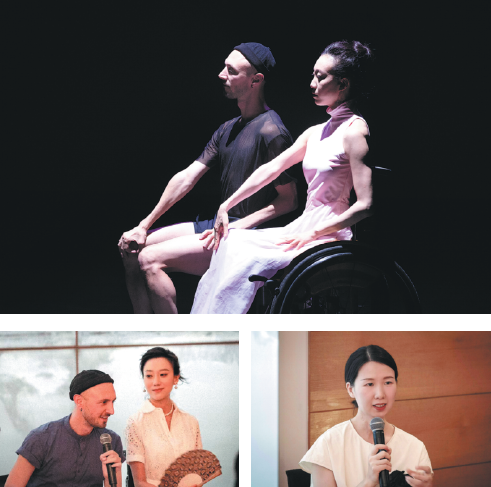

Clockwise from above: The production is a collaboration by Liu Yan and Swiss artist Alessandro Schiattarella. Ge Huichao, founder of the annual inclusive arts-centered Luminous Festival, speaks at a news conference in Beijing on July 4. Schiattarella and Liu address the conference. LI XIAOCAO/FOR CHINA DAILY
"I remember a line from one of Liu's books, where she said that hands were her new means of expression. It is the same for me. We come from different cultures, but we're so connected by something I found really striking. I felt that we had to go further into this."
In choreography devised and performed by both dancers, they tell their own stories and communicate with each other via intricate hand gestures and movements that blend both Chinese and Western classical and contemporary dance elements, amplified and highlighted by lighting.
For Schiattarella, the production draws from autobiographical dance pieces in which he explores the movements his hands are able to perform, but also adds cultural elements, such as those of his birthplace Naples, in Italy.
"There is a tradition of using hands in specific ways in daily life in Naples. Neapolitans speak a lot with their hands, to the point that there are books describing all the gestures. Then we also dug into the arts, the iconic images of hands in paintings and sculptures, to enrich the choreography," he says.
For the production, Liu choreographed a section specifically using hand movements from traditional Chinese dance. She says that while the basic hand gestures in ballet are the same for men and women, some of the dozens of hand gestures in traditional Chinese dance are specific to certain genders.
Initially concerned about whether the different genres would work together in the same production, Liu says that when she heard the music, she spontaneously began to interpret it through dance.
"For me, this section flows naturally with the other passages, which represent an interesting contrast of cultural differences," she says.
The music is composed by Li Bo and Zhang Yong, the two founders of Silent Choir, an ensemble of children and teenagers with hearing impairments. For the production, they used a pipa (a four-stringed lute) to imitate the sound of Neapolitan music.
As the production's producer and dramaturge, Ge says that the creation and rehearsal process involved constant brainstorming of imagery related to hands, resulting in a harmonious blend of the contemporary, the classical and the folk.
"I hope that the audience will feel the production's sense of fun, uniqueness and inclusiveness. I feel that it is a bold collaboration and exploration based on the connection between the two artists," Ge says.
The production is sponsored by Pro Helvetia, the Swiss Arts Council, with the aim of promoting Sino-Swiss cultural exchange and supporting inclusive arts.
"From my experience of promoting inclusive arts, I know how challenging it is to work in this field, and we deeply appreciate the talent, possibility and creativity of artists with disabilities," Ge says.
"We look forward to fostering inclusive arts exchanges between China and Switzerland, beginning with Handling Hands, a fine starting point for future collaboration."
Contact the writer at chengyuezhu@chinadaily.com.cn